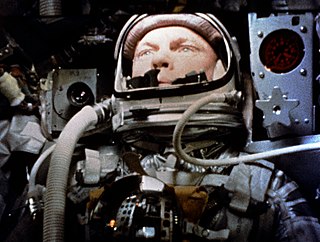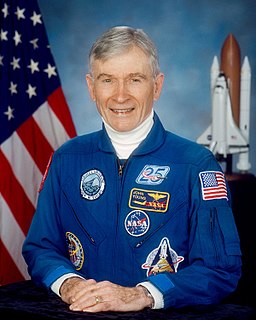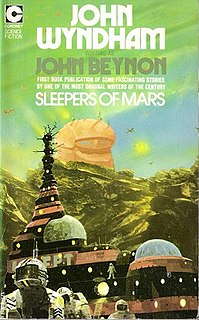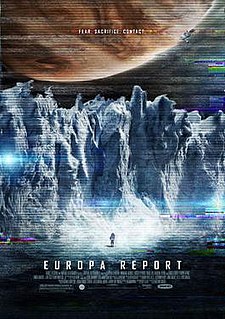
Extravehicular activity (EVA) is any activity done by an astronaut outside a spacecraft beyond the Earth's appreciable atmosphere. Normally, the term applies to what has been termed a spacewalk outside a craft that is orbiting Earth. However EVA also applies to lunar surface exploration, as performed by six pairs of American astronauts in the Apollo program from 1969 to 1972. A stand-up EVA (SEVA) is when an astronaut does not fully leave a spacecraft, but is completely reliant on the space suit for environmental support. Its name derives from the astronaut "standing up" in the open hatch, usually to record or assist a spacewalking astronaut. The Soviet Union/Russia, the United States, Canada, the European Space Agency and China have all conducted EVAs.

Project Mercury was the first human spaceflight program of the United States, running from 1958 through 1963. An early highlight of the Space Race, its goal was to put a man into Earth orbit and return him safely, ideally before the Soviet Union. Taken over from the US Air Force by the newly created civilian space agency NASA, it conducted 20 uncrewed developmental flights, and six successful flights by astronauts. The program, which took its name from Roman mythology, cost $2.38 billion. The astronauts were collectively known as the "Mercury Seven", and each spacecraft was given a name ending with a "7" by its pilot.

A spacecraft is a vehicle or machine designed to fly in outer space. A type of artificial satellite, spacecraft are used for a variety of purposes, including communications, Earth observation, meteorology, navigation, space colonization, planetary exploration, and transportation of humans and cargo. All spacecraft except single-stage-to-orbit vehicles cannot get into space on their own, and require a launch vehicle.

Gemini 3 was the first crewed mission in NASA's Project Gemini and was the first time two American astronauts flew together into space. On March 23, 1965, astronauts Gus Grissom and John Young flew three low Earth orbits in their spacecraft, which they nicknamed Molly Brown. It was the first U.S. mission in which the crew fired thrusters to change the size and shape of their orbit, a key test of spacecraft maneuverability vital for planned flights to the Moon. It was also the final crewed flight controlled from Cape Kennedy Air Force Station in Florida, before mission control functions were moved to a new control center at the newly opened Manned Spacecraft Center in Houston, Texas.

Mercury-Redstone 3, or Freedom 7, was the first United States human spaceflight, on May 5, 1961, piloted by astronaut Alan Shepard. It was the first crewed flight of Project Mercury. The project had the ultimate objective of putting an astronaut into orbit around the Earth and returning him safely. Shepard's mission was a 15-minute suborbital flight with the primary objective of demonstrating his ability to withstand the high g-forces of launch and atmospheric re-entry.

Mercury-Atlas 6 (MA-6) was the first crewed American orbital spaceflight, which took place on February 20, 1962. Piloted by astronaut John Glenn and operated by NASA as part of Project Mercury, it was the fifth human spaceflight, preceded by Soviet orbital flights Vostok 1 and 2 and American sub-orbital flights Mercury-Redstone 3 and 4.

Mercury-Atlas 8 (MA-8) was the fifth United States crewed space mission, part of NASA's Mercury program. Astronaut Walter M. Schirra Jr., orbited the Earth six times in the Sigma 7 spacecraft on October 3, 1962, in a nine-hour flight focused mainly on technical evaluation rather than on scientific experimentation. This was the longest U.S. crewed orbital flight yet achieved in the Space Race, though well behind the several-day record set by the Soviet Vostok 3 earlier in the year. It confirmed the Mercury spacecraft's durability ahead of the one-day Mercury-Atlas 9 mission that followed in 1963.

John Watts Young was an American astronaut, naval officer and aviator, test pilot, and aeronautical engineer. He became the ninth person to walk on the Moon as commander of the Apollo 16 mission in 1972. He is the only astronaut to fly on four different classes of spacecraft: Gemini, the Apollo command and service module, the Apollo Lunar Module and the Space Shuttle.
A service module is a component of a crewed space capsule containing a variety of support systems used for spacecraft operations. Usually located in the uninhabited area of the spacecraft, the service module serves a storehouse of critical subsystems and supplies for the mission such as electrical systems, environmental control, and propellant tanks. The service module is jettisoned upon the completion of the mission, and usually burns up during atmospheric reentry.

A space capsule is an often-crewed spacecraft that uses a blunt-body reentry capsule to reenter the Earth's atmosphere without wings. Capsules are distinguished from other satellites primarily by the ability to survive reentry and return a payload to the Earth's surface from orbit. Capsule-based crewed spacecraft such as Soyuz or Orion are often supported by a service or adapter module, and sometimes augmented with an extra module for extended space operations. Capsules make up the majority of crewed spacecraft designs, although one crewed spaceplane, the Space Shuttle, has flown in orbit.

Sleepers of Mars is a collection of early short stories by British writer John Wyndham, published after his death, in 1973 by Coronet Books.

Manned Venus Flyby was a 1967–1968 NASA proposal to send three astronauts on a flyby mission to Venus in an Apollo-derived spacecraft in 1973–1974, using a gravity assist to shorten the return journey to Earth.

Katherine Megan McArthur is an American oceanographer, engineer, and NASA astronaut. She has served as a Capsule Communicator (CAPCOM) for both the Space Shuttle and International Space Station (ISS). Megan McArthur has flown one space shuttle mission, STS-125 and one SpaceX mission, SpaceX Crew-2 on Crew Dragon Endeavour. She is known as the last person to be hands on with the Hubble Space Telescope via the Canadarm. McArthur has served in a number of positions including working in the Shuttle Avionics Laboratory (SAIL). She is married to fellow astronaut Robert L. Behnken.

The United States Spacecraft Discovery One is a fictional spaceship featured in the first two novels of the Space Odyssey series by Arthur C. Clarke and in the films 2001: A Space Odyssey (1968) directed by Stanley Kubrick and 2010: The Year We Make Contact (1984) directed by Peter Hyams. The ship is a nuclear-powered interplanetary spaceship, crewed by two men and controlled by the AI on-board computer HAL 9000. The ship is destroyed in the second novel and makes no further appearances.

Gaganyaan is an Indian crewed orbital spacecraft intended to be the formative spacecraft of the Indian Human Spaceflight Programme. The spacecraft is being designed to carry three people, and a planned upgraded version will be equipped with rendezvous and docking capability. In its maiden crewed mission, Indian Space Research Organisation (ISRO)'s largely autonomous 5.3 metric tonnes capsule will orbit the Earth at 400 km altitude for up to seven days with a two or three-person crew on board. The first crewed mission was originally planned to be launched on ISRO's GSLV Mk III in December 2021, but this has since been delayed to no earlier than 2024.
Red Bull Stratos was a high altitude skydiving project involving Austrian skydiver Felix Baumgartner. On 14 October 2012, Baumgartner flew approximately 39 kilometres (24 mi) into the stratosphere over New Mexico, United States, in a helium balloon before free falling in a pressure suit and then parachuting to Earth. The total jump, from leaving the capsule to landing on the ground, lasted approximately ten minutes. While the free fall was initially expected to last between five and six minutes, Baumgartner deployed his parachute after 4 minutes and 19 seconds.

Europa Report is a 2013 American science fiction film directed by Sebastián Cordero and written by Philip Gelatt. It stars Christian Camargo, Anamaria Marinca, Michael Nyqvist, Daniel Wu, Karolina Wydra, and Sharlto Copley. A found footage film, it recounts the fictional story of the first crewed mission to Europa, one of the four Galilean moons of Jupiter. Despite a disastrous technical failure that causes the loss of all communications with Earth, and a series of further crises, the crew continues its mission to Europa and finds mounting evidence of life on this Galilean moon of Jupiter.

SpaceX CRS-21, also known as SpX-21, was a Commercial Resupply Service mission to the International Space Station which launched on 6 December 2020. The mission was contracted by NASA and was flown by SpaceX using a Cargo Dragon 2. This was the first flight for SpaceX under NASA's CRS Phase 2 contract awarded in January 2016. This was also the first Cargo Dragon of the new Dragon 2 variant, as well as the first Cargo Dragon flight that was docked at the same time as a Crew Dragon spacecraft. This mission used Booster B1058.4, becoming the first NASA mission to reuse a booster previously used on a non-NASA mission. This was also first time SpaceX launched a NASA payload on a booster with more than one previous flight.

The Commercial Crew Program (CCP) provides commercially-operated crew transportation service to and from the International Space Station (ISS) under contract to NASA, conducting crew rotations between the expeditions of the International Space Station program. American space manufacturer SpaceX began providing service in 2020, using the Crew Dragon spacecraft, and NASA plans to add Boeing when its Boeing Starliner spacecraft becomes operational some time after 2022. NASA has contracted for six operational missions from Boeing and fourteen from SpaceX, ensuring sufficient support for ISS through 2030.
















